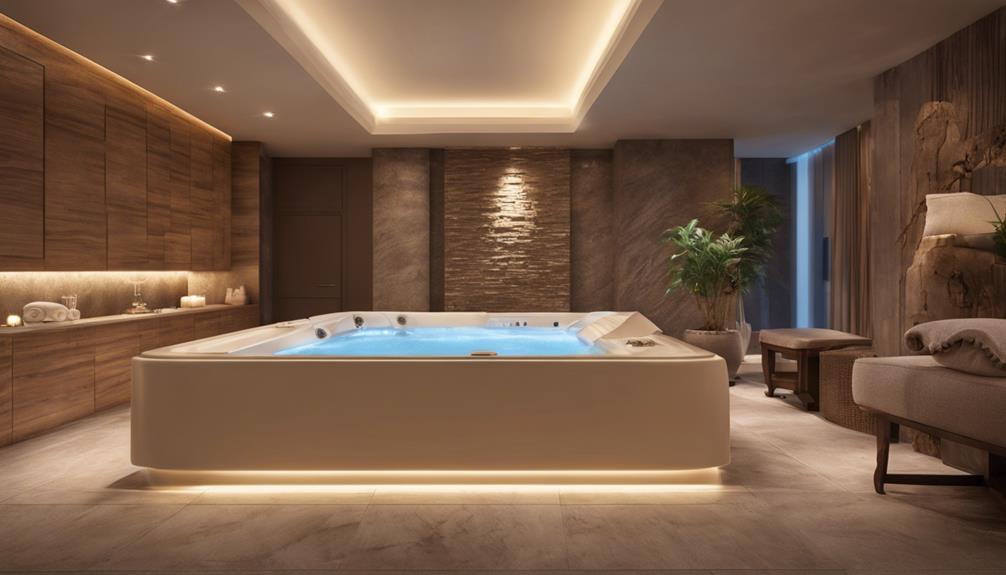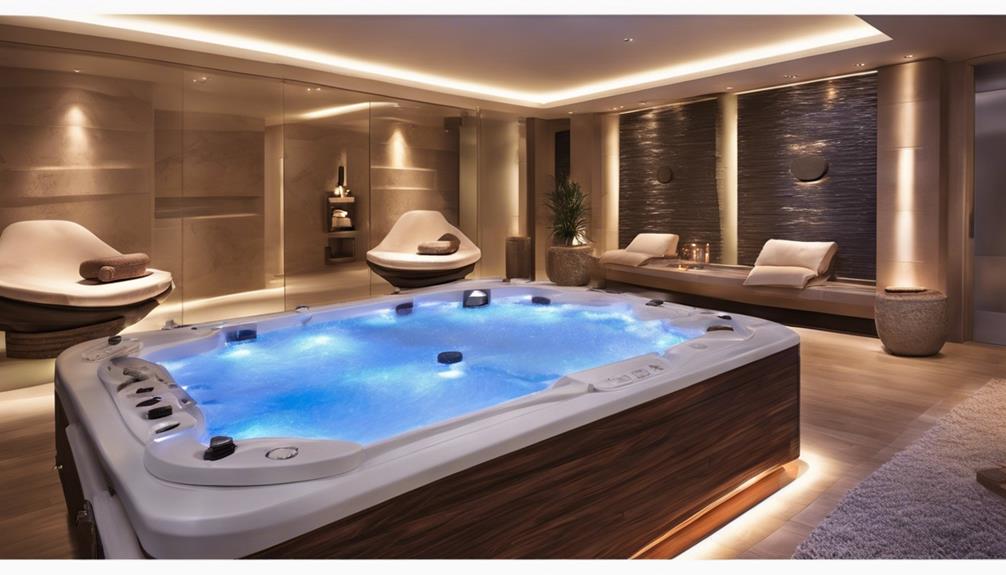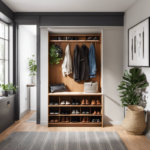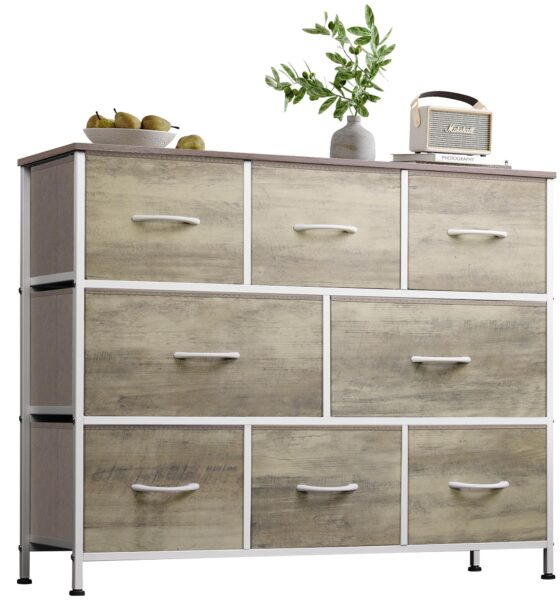Retreat
How Do You Create Space in a Studio

Are you tired of feeling cramped in your studio apartment? We’ve got the solutions you need to create more space and make the most of your living area.
In this article, we’ll share our expert tips on:
- Utilizing vertical space
- Incorporating multifunctional furniture
- Maximizing storage solutions
- Creating distinct zones within your studio
Plus, we’ll reveal light and color techniques that will give your space a spacious feel.
Get ready to transform your studio into a place of comfort and functionality.
Key Takeaways
- Incorporate shelves and wall-mounted storage solutions
- Utilize vertical gardening and suspended storage solutions
- Look for multifunctional furniture and consider furniture arrangement
- Create zones within the studio using furniture placement and room dividers
Utilizing Vertical Space
We can maximize our use of vertical space in a studio by incorporating shelves and wall-mounted storage solutions.
Vertical gardening is an excellent way to utilize this space, allowing us to grow plants and herbs while adding a touch of nature to our living area.
By installing suspended storage solutions, such as hanging baskets or hooks, we can efficiently store items like pots, pans, and utensils, keeping them within easy reach while freeing up valuable counter space.
Additionally, wall-mounted shelves provide a stylish and functional solution for storing books, decorative items, and other essentials, helping to keep the studio organized and clutter-free.
These storage solutions not only optimize the available vertical space but also add visual interest and personality to the studio, creating a more inviting and efficient living environment.
Multifunctional Furniture Ideas
How can we incorporate multifunctional furniture ideas to maximize space in a studio?
Compact storage: Look for furniture pieces that offer hidden storage compartments or built-in shelves to keep your belongings organized and out of sight. This will help you maximize the use of your limited space.
Convertible furnishings: Opt for furniture that can serve multiple purposes. For example, a sofa bed can be used as a seating area during the day and easily converted into a bed for guests at night. A dining table with collapsible sides can be expanded when needed and folded down when not in use, freeing up valuable floor space.

Customizable options: Consider furniture that can be customized to fit your specific needs. Modular furniture, such as shelving units or storage cabinets, can be rearranged and reconfigured as your space requirements change.
By incorporating these multifunctional furniture ideas, you can make the most of your studio space while still having all the necessary furnishings.
Now let’s explore how to maximize storage solutions even further.
Maximizing Storage Solutions
To maximize storage solutions, we can utilize vertical space and incorporate hanging organizers. In a small studio apartment, it’s crucial to find inventive ways to maximize storage and keep everything organized.

Vertical space is often overlooked but can be a game-changer in creating more storage options. Installing floating shelves or using wall-mounted storage units can effectively utilize the vertical space.
Another smart storage hack is incorporating hanging organizers. These can be used for various purposes like storing shoes, accessories, or even kitchen supplies. Hanging organizers can be hung on doors, walls, or even from the ceiling, providing additional storage without taking up valuable floor space.
Creating Zones Within a Studio
By dividing the studio into separate zones with different functions, such as a sleeping area, a workspace, and a living area, we can maximize the functionality and create distinct areas within the limited space. This not only helps to organize the studio but also creates a sense of purpose and order.
Here are some ways to create zones within a studio:
Furniture arrangement: Strategically placing furniture can define different areas in the studio. For example, placing a bed against one wall can create a sleeping area, while positioning a desk and chair near a window can establish a workspace.
Room dividers: Utilizing room dividers can physically separate different zones within the studio. This can be done with bookshelves, curtains, or even folding screens. These dividers not only provide privacy but also add visual interest to the space.
Color and lighting: Using different colors and lighting techniques can help differentiate various zones within the studio. Painting one wall a different color or adding task lighting to specific areas can visually separate and define each zone.
Light and Color Techniques for a Spacious Feel
As we explore light and color techniques for a spacious feel in a studio, we can utilize different strategies to enhance the perception of space and create an open and airy atmosphere. One effective way to achieve this is by incorporating mirrors and reflections into the studio’s design. Placing mirrors strategically can create the illusion of depth and make the space appear larger than it actually is. Additionally, mirrors can reflect natural light and distribute it throughout the room, making it feel brighter and more expansive. Another technique is to embrace minimalist decor. By keeping the space clutter-free and using a simple color palette, the studio will feel more open and spacious. Minimalist furniture and accessories with clean lines can also contribute to a sense of openness. By employing these light and color techniques, we can create a studio that feels spacious and inviting.
| Techniques | Benefits |
|---|---|
| Mirrors and reflections | Create the illusion of depth and distribute natural light |
| Minimalist decor | Keep the space clutter-free and create a sense of openness |
Frequently Asked Questions
What Are Some Tips for Organizing and Decluttering a Small Studio Space?
When it comes to organizing and decluttering a small studio space, our tips include maximizing storage to create separate areas for different activities. Our professional, informative, and detailed approach serves those seeking to serve others.
Are There Any Specific Design Elements or Furniture Arrangements That Can Visually Create the Illusion of More Space in a Studio?
Optical illusions and space-saving furniture are key to visually creating the illusion of more space in a studio. By strategically placing mirrors, using light colors, and investing in multifunctional furniture, we can maximize the perceived space in a small studio.
How Can I Incorporate Plants Into My Studio to Add a Sense of Freshness and Openness?
Incorporating plants into our studio not only adds a sense of freshness and openness, but also brings the benefits of natural lighting and indoor gardening. It creates a harmonious and vibrant atmosphere that enhances our well-being and creativity.
Are There Any Creative Ways to Incorporate Artwork or Decorative Elements Without Overwhelming a Small Studio Space?
Incorporating artwork without overwhelming a small space can be achieved through creative ways to decorate a small studio. By strategically placing artwork and utilizing decorative elements, we can enhance the space without compromising its size.
What Are Some Practical Tips for Maintaining a Clean and Organized Studio Space on a Daily Basis?
When it comes to maintaining a clean and organized studio space on a daily basis, we’ve found some practical tips for maximizing storage and creating designated workspaces in small studios.
Can the Layout of a Coworking Space Be Applied to Creating Space in a Studio?
When creating space in a studio, consider the efficient and collaborative “layout a coworking space“. Incorporate shared work areas, flexible furniture, and designated zones for various activities. Emphasize natural light and open space to enhance creativity and productivity. Adapt the principles of a coworking space to optimize the layout of your studio.
– Can the Design of Dancewear Help Create Space in a Studio?
When it comes to studio space, the design of dancewear article can play a significant role. Well-constructed, breathable fabrics that move with the dancer can help create more physical space in a crowded studio. Additionally, bold colors and patterns can add visual interest, making the space feel more open and inviting.
Conclusion
In conclusion, creating space in a studio requires thoughtful planning and clever design choices. By utilizing vertical space, incorporating multifunctional furniture, and maximizing storage solutions, you can make the most of your limited space.
Additionally, creating distinct zones within the studio and using light and color techniques can help create a spacious feel.
Remember, Rome wasn’t built in a day, so take your time and be patient while implementing these strategies to create a studio that feels open and inviting.
- About the Author
- Latest Posts
Introducing Charles, the Editor in Chief at ByRetreat, whose passion for interior design and editorial excellence elevates every remote workspace to new heights. With his keen eye for detail, impeccable taste, and expertise in design, Charles brings a wealth of knowledge and creativity to the ByRetreat team.
As the Editor in Chief of a renowned lifestyle blog, Charles has honed his skills in curating captivating content and staying up-to-date with the latest trends in interior design. His deep understanding of aesthetics and the power of storytelling through design enables him to create remote workspaces that are not only visually stunning but also rich in personality and meaning.
Retreat Ideas
Ultimate Women's Church Retreat Ideas Guide
Open your mind to the ultimate women's retreat experience with transformative ideas that will leave you inspired and empowered!

As we gathered in the serene mountainside retreat center, the women's eyes sparkled with anticipation for the weekend ahead. With a carefully crafted schedule of workshops, meditation sessions, and group discussions, the energy of transformation hummed in the air.
But what truly made this women's retreat unforgettable? Stay tuned to discover the key elements that set this experience apart and how you can replicate its success in your own gatherings.
Key Takeaways
- Choose a theme that fosters personal growth and community unity.
- Plan with clear goals, diverse agendas, and engaged volunteers.
- Engage in reflective, creative, and community bonding activities.
- Strengthen connections through shared experiences, worship, and support.
Women's Retreat Theme Ideas
When brainstorming women's retreat theme ideas, we aim to evoke a sense of purpose and unity among participants through carefully selected themes that inspire personal growth and spiritual connection.
In the kingdom of women's ministry retreats, the theme serves as the guiding light for the entire event. Themes such as 'Unshakable Faith' and 'Fearless and Free' can shape the retreat's teachings and activities, fostering a deep sense of Christian community and spiritual growth.
For a more introspective approach, themes like 'Abiding in Christ' and 'Be Still and Know' emphasize prayer, reflection, and dedicated time with God. Each theme has the power to inspire different facets of personal development and fellowship among participants, creating a transformative experience for all involved.
Planning a Successful Retreat

As we embark on the journey of planning a successful retreat, setting clear goals and objectives is paramount to guiding our preparation and execution effectively. When delving into the world of women's ministry retreat planning, several key factors must be considered to make certain a memorable and impactful experience for all participants:
- Choose a Meaningful Theme: Select a theme that resonates with the attendees and aligns with the mission of the ministry. A well-chosen theme sets the tone for the entire retreat and helps focus the activities and discussions towards a common goal.
- Craft a Diverse Agenda: Develop a detailed agenda that includes a mix of spiritual, interactive, and community-building activities. This variety caters to the diverse interests and needs of the participants, making sure everyone finds something meaningful and engaging.
- Recruit and Train Volunteers: Engage volunteers to support various aspects of the retreat, from logistics to leading sessions. Well-trained volunteers enhance participant engagement and contribute to the overall success of the retreat.
Engaging Activity Suggestions
Let's explore a plethora of enchanting activity suggestions designed to enhance the women's church retreat experience. Engaging activities for women's ministry retreats can encompass a variety of experiences tailored to foster spiritual connections, interactive learning, and community bonding. Below is a table showcasing some engaging ideas for your upcoming retreat:
| Activity | Description |
|---|---|
| Outdoor Collages | Encourage participants to create collages using natural elements found outdoors, promoting reflection and creativity. |
| Journaling | Provide guided journal prompts for personal growth and self-reflection, allowing attendees to probe deeper into their spiritual journey. |
| Salt Covenant | Symbolize commitment and unity through the Salt Covenant, a powerful ritual that can strengthen relationships and faith bonds. |
| Biblical Women Exploration | Engage in interactive sessions exploring the lives of biblical women, drawing inspiration and lessons for modern-day living. |
| Community Bonding | Foster connections through bonfire sessions, special gatherings, and team-building activities that promote support and friendship among participants. |
These activities aim to create a holistic and meaningful retreat experience where women can grow spiritually, connect with one another, and deepen their understanding of biblical teachings.
Creating Meaningful Connections

To cultivate deep and meaningful connections at a women's church retreat, we focus on fostering authentic relationships and bonding through shared experiences. Engaging in activities like sisterhood circles, testimony panels, and prayer walks creates an environment where women can open up, share their stories, and connect on a deeper level.
These structured settings provide opportunities for vulnerability and empathy, enabling participants to build trust and support one another through their journeys. Acts of kindness, such as small gestures and thoughtful deeds, serve as powerful tools in strengthening the connections formed during the retreat.
Moreover, incorporating creative worship sessions that encourage self-expression and spiritual growth can further solidify the sense of community among women. By emphasizing community building within the women's ministry, we make certain that the retreat becomes a space where lasting bonds are forged, and the spirit of sisterhood thrives.
Evaluating Retreat Success
In evaluating the success of a retreat, feedback from participants can provide valuable insights into the impact of the experience on their spiritual growth and personal development. Collecting feedback through surveys or interviews allows organizers to assess the achievement of retreat goals and measure the retreat's influence on individuals. Reviewing pre-established objectives helps in understanding whether the retreat met its intended purposes and contributed to the participants' growth.
Attendance rates and engagement levels are vital indicators to analyze when evaluating retreat success. High attendance rates and active participation often indicate a successful and engaging retreat experience. Considering financial indicators like budget adherence and return on investment can provide a thorough view of the retreat's overall success.
Frequently Asked Questions
What Do You Do at a Women's Church Retreat?
At a women's church retreat, we engage in spiritual growth activities like prayer, worship, and Bible study sessions. We build relationships, participate in small group discussions, workshops, and creative arts activities to empower, heal, and grow spiritually.
How Do You Make a Successful Women's Retreat?
We make a successful women's retreat by crafting a clear agenda with diverse activities. Selecting a resonant theme, tranquil location, and best timing. Focusing on connections, spiritual reflection, and personal growth fosters an enriching experience.
What Are the Topics for Women's Retreat Discussion?
We explore various themes including spiritual growth, self-care, relationships, leadership development, and identity in Christ. Engaging discussions cover empowerment, purpose-driven life, healing, trust, and building relationships. Topics focus on identity, ministry, testimony, spiritual qualities, and inner healing.
How Do You Structure a Spiritual Retreat?
When structuring a spiritual retreat, we focus on setting clear goals for growth and renewal. We incorporate activities like worship, prayer, Bible study, and group discussions, ensuring a balance of reflection and connection.
Conclusion
As we reflect on our journey through planning the ultimate women's church retreat, we can't help but marvel at the way every detail fell into place.
From selecting the perfect theme to engaging activities and creating meaningful connections, it all came together effortlessly.
Our retreat was a true evidence to the power of collaboration and intentionality.
We're grateful for the transformative experience and the lasting impact it had on all who attended.
- About the Author
- Latest Posts
Introducing Ron, the home decor aficionado at ByRetreat, whose passion for creating beautiful and inviting spaces is at the heart of his work. With his deep knowledge of home decor and his innate sense of style, Ron brings a wealth of expertise and a keen eye for detail to the ByRetreat team.
Ron’s love for home decor goes beyond aesthetics; he understands that our surroundings play a significant role in our overall well-being and productivity. With this in mind, Ron is dedicated to transforming remote workspaces into havens of comfort, functionality, and beauty.
Spa Design
Why Design a Spa De Nage for Your Home?
Prepare for a luxurious escape in your backyard with a spa de nage, offering a perfect blend of relaxation and wellness – discover more!

When we envision creating a luxurious oasis in our own backyard, the idea of a spa de nage emerges as a compelling choice. Picture this: a blend of relaxation, exercise, and wellness, all conveniently at your fingertips.
But there's more to this than meets the eye. From enhancing your daily routine to fostering a sense of well-being, the benefits of having a spa de nage are vast and intriguing.
So, why not explore further and uncover how this addition can transform your home into a haven of rejuvenation?
Key Takeaways
- Spa De Nage combines pool and spa benefits in one
- Enhances physical and mental well-being with customizable features
- Offers cost-effective alternative with energy-efficient design
- Provides relaxation, exercise, and health benefits in one unit
Benefits of Having a Spa De Nage
Immerse yourself in the luxurious fusion of a swimming pool and spa with the innovative swim spas, redefining relaxation and fitness in the comfort of your own home. These marvels of modern design offer a unique combination of benefits that cater to both your leisure and health needs.
One of the standout features of swim spas is the incorporation of a counter-current swimming system. This system allows for customized aquatic workouts, perfect for individuals looking to enhance their swimming skills or engage in low-impact exercises. Models like the Amazonas Turbine and the Danube Turbine from Wellis provide not only a space for physical activity but also a sanctuary for relaxation. The hydrotherapy jets in these swim spas offer muscle pain relief and contribute to overall health improvements.
Design Considerations for Spa De Nage

In exploring the optimal design considerations for a Spa De Nage, we delve into key elements that elevate both functionality and relaxation within this innovative home feature.
When designing a Spa De Nage, size and depth variations play a crucial role in catering to different needs and preferences, ensuring an ideal space for both swimming and relaxation. The layout and positioning of hydromassage jets are pivotal, offering targeted muscle relief and enhancing the overall swim experience.
Energy-efficient insulation is a must-have, maintaining water temperature efficiently and reducing operational costs in the long run. Customizable features such as lighting, sound systems, and water flow options add a touch of luxury, elevating the ambiance of the spa.
When selecting a Spa De Nage, choosing a reputable brand is essential to guarantee quality construction, durability, and optimal performance over time. These design considerations collectively contribute to creating a luxurious and functional Spa De Nage that enhances your home living experience.
Wellness Features of Spa De Nage
Enhance your wellness journey with the invigorating features of Wellis Swim Spas, designed to elevate your physical and mental well-being through customizable hydrotherapy experiences.
Wellis Swim Spas offer a unique counter-current swimming system that provides a real waterway sensation right in the comfort of your home. The adjustable flow rate caters to individual needs, accommodating various swimming styles for a personalized workout experience. By swimming against the current, you can engage in balneo therapy tailored to reduce muscular pain and tension, promoting relaxation and rejuvenation.
These swim spas aren't just for fitness but also for holistic wellness. Low-impact swim spa workouts can enhance blood circulation, improve cardiovascular health, and offer muscle pain relief. Regular use of Wellis Swim Spas can contribute to stress reduction and overall well-being.
Dive into the world of innovative hydrotherapy with Wellis Swim Spas to transform your home into a sanctuary for wellness and vitality.
Maintenance Tips for Spa De Nage

To ensure optimal performance and longevity of your Spa De Nage, it's crucial to adhere to a regular maintenance routine.
Keeping the swim spa filter clean is essential for maintaining water quality and circulation efficiency, ensuring a refreshing and hygienic swim experience.
Monitoring and adjusting the swim spa's chemical levels according to manufacturer recommendations is key to preserving the water balance and preventing any issues that may affect the swim spa's components.
Regularly inspecting the swim spa cover for damage or wear and tear is necessary to maintain proper insulation, which can help conserve energy and keep operating costs down.
Checking the water level of the swim spa frequently and topping it up as needed is important to prevent damage to the pump and ensure smooth operation.
Lastly, scheduling routine maintenance checks with a professional will help identify any potential issues early on, ensuring the swim spa's optimal performance and longevity.
Cost-Effectiveness of Spa De Nage
Exploring the cost-effectiveness of Spa De Nage reveals a smart investment choice that combines affordability with year-round enjoyment and savings. Swim spas offer a budget-friendly alternative to traditional pools due to their lower installation and maintenance costs.
The price range for swim spas caters to various budgets and preferences, making it accessible to a wide range of homeowners. Not only are swim spas designed for year-round use, but they also provide cost savings on electricity and water bills thanks to their energy-efficient features.
By combining a pool and a hot tub in one versatile unit, swim spas offer multiple benefits at a fraction of the cost of separate installations. This cost-effectiveness makes a swim spa a compelling choice for those seeking a luxurious swimming experience without breaking the bank.
With the ability to swim, relax, and entertain, a swim spa proves to be a wise investment for both your lifestyle and your wallet.
Frequently Asked Questions
What Are the Benefits of Having a Spa Bath?
Having a spa bath brings relaxation, improves circulation, and boosts cardiovascular health. It offers customizable settings for a luxurious experience and adds value to our home. A spa de nage is a perfect blend of wellness and luxury.
What Are the Health Benefits of a Hot Tub?
Using a hot tub offers a plethora of health benefits. It relieves muscle tension, promotes relaxation, releases endorphins, improves strength and flexibility, enhances joint mobility, reduces stress, boosts metabolism, and aids in better sleep patterns.
What Are Custom Spas Designed and Built on Site Typically Made Of?
We opt for high-quality acrylic material for our custom spas. It's durable, non-porous, and easily maintained. This material resists stains, chemicals, and UV fading. Our spas offer endless possibilities for shape, size, and color customization.
What Are the Disadvantages of a Hot Tub?
Disadvantages of hot tubs include high maintenance needs, dehydration risks, limited seating, unsuitability for certain health conditions, and significant energy costs. We must consider these factors when deciding on a spa.
Conclusion
In conclusion, designing a spa de nage for your home is like adding a pearl to an oyster: it enhances the beauty and value of your property while offering a versatile space for exercise, relaxation, and wellness.
With its numerous benefits, low maintenance requirements, and year-round usability, a swim spa is a smart investment that caters to all your physical and mental health needs.
Make your home a sanctuary with a spa de nage today!
- About the Author
- Latest Posts
Introducing Ron, the home decor aficionado at ByRetreat, whose passion for creating beautiful and inviting spaces is at the heart of his work. With his deep knowledge of home decor and his innate sense of style, Ron brings a wealth of expertise and a keen eye for detail to the ByRetreat team.
Ron’s love for home decor goes beyond aesthetics; he understands that our surroundings play a significant role in our overall well-being and productivity. With this in mind, Ron is dedicated to transforming remote workspaces into havens of comfort, functionality, and beauty.
Spa Design
Ultimate Spa Jacuzzi Design Guide
Cascading into a world of sophistication and serenity, the Ultimate Spa Jacuzzi Design Guide unveils the secrets to creating an unrivaled outdoor sanctuary.

As we explore the nuances of spa jacuzzi design, envision a scenario where your outdoor retreat transforms into a sanctuary of tranquility and luxury. Imagine the perfect blend of elegance and functionality seamlessly integrated into your living space.
Each decision, from the selection of materials to the incorporation of innovative features, plays a pivotal role in curating an unparalleled spa experience. Join us on this journey as we unravel the intricate details and considerations that culminate in the creation of the ultimate spa jacuzzi oasis.
Key Takeaways
- Customize spa jacuzzi sizing and style for personal preferences.
- Enhance relaxation with soothing features and accessories.
- Design for functionality, balance, and visual appeal.
- Explore innovative features and landscaping integration for a luxurious spa experience.
Spa Jacuzzi Sizing and Styles
When selecting a Spa Jacuzzi, the sizing and styles available cater to diverse preferences and needs, offering a range from intimate models for two to spacious designs accommodating up to ten individuals. These spa jacuzzis come in various sizes, with compact models perfect for cozy evenings and larger ones ideal for hosting gatherings or family relaxation sessions.
The styles range from traditional round or square shapes to more modern and sleek designs, ensuring that there's a perfect fit for every aesthetic taste. Some Spa Jacuzzis boast adjustable seating options, ergonomic designs, and advanced hydrotherapy features, providing a personalized spa experience tailored to individual needs.
Outdoor Spa Jacuzzis can transform your backyard into a luxurious oasis, seamlessly integrated into pool designs for a stunning visual impact. On the other hand, indoor Spa Jacuzzis offer year-round relaxation and can be customized to blend seamlessly with your home's interior design, creating a spa-like retreat right at home.
The customizable features and luxurious designs make each Spa Jacuzzi a unique and inviting space for ultimate relaxation and rejuvenation.
Soothing Features and Accessories

Enhancing your Jacuzzi experience with luxurious features and accessories transforms relaxation into a personalized oasis of comfort and style. Customize your spa area with adjustable water jets, allowing for targeted massage therapy to soothe tired muscles.
Elevate your relaxation with aromatherapy using essential oil diffusers, creating a serene spa-like atmosphere. Set the mood with customizable LED lighting options, offering a range of colors to enhance the calming ambiance of your Jacuzzi retreat.
For an added touch of luxury, consider installing built-in sound systems or Bluetooth speakers to enjoy entertainment or relaxation music while unwinding in the warm waters. Comfort accessories such as headrests, cup holders, and towel racks further elevate the overall spa experience, providing convenience and style.
With these customizable features and accessories, your Jacuzzi becomes a haven of relaxation, where you can indulge in a sensory experience that rejuvenates both body and mind.
Designing for Functionality and Relaxation
To create a harmonious blend of function and relaxation in your spa Jacuzzi design, meticulous planning of the layout is essential to seamlessly integrate indoor and outdoor spaces with a cohesive theme. When designing for functionality and relaxation, consider the following:
- Accessibility: Position the spa area in a way that allows for easy access from the home or patio, ensuring convenience for users.
- Cohesive Design: Maintaining a balance between the pool and spa designs is crucial for creating a unified and visually appealing outdoor space.
- Visual Appeal: Pay attention to the proximity of the pool to the spa area to achieve a seamless and aesthetically pleasing design that enhances the overall ambiance of your backyard retreat.
Innovative Spa Jacuzzi Features

Embracing cutting-edge design concepts, our spa Jacuzzi features exude a blend of luxury and functionality that redefine relaxation in your outdoor oasis. To create a truly innovative spa experience, we incorporate a range of features that cater to your every need. Enhance ambiance with custom water features like cascading waterfalls that create a soothing atmosphere. Imagine cozy evenings around fire pits, adding warmth and charm to your outdoor space. Illuminate the spa area with energy-efficient LED lighting, offering a captivating and visually stunning look. For a touch of entertainment, consider adding swim-up bars, providing a unique experience for you and your guests. Opt for modern pool system automation and smart technology for seamless control and convenience. Explore the possibilities of a spa Jacuzzi that not only relaxes but also delights with these exceptional features.
| Water Features | Fire Elements | LED Lighting |
|---|---|---|
| Custom waterfalls | Fire pits | Energy-efficient |
| Soothing atmosphere | Cozy ambiance | Captivating look |
| Swim-Up Bars | Pool System Automation | Smart Technology |
| Unique experience | Convenience and ease of use | Seamless control |
Landscaping and Hardscaping Integration
Integrating landscaping and hardscaping elements seamlessly transforms the pool area into a harmonious outdoor oasis. When considering landscape design, opt for lush greenery and durable materials like concrete or natural stone to blend nature with structure.
For seating options, choose comfortable loungers or dining sets that invite relaxation and quality time by the water. Privacy walls or screens can offer intimacy and safety while enhancing the aesthetic appeal of the space.
In terms of design choices, incorporate elements like lighting options to create ambiance and extend pool usage into the evening. Additionally, prioritize water care with low-maintenance plants and drought-tolerant species to ensure a vibrant and sustainable environment.
Frequently Asked Questions
What Is the Average Life of a Jacuzzi Hot Tub?
We've found that the average lifespan of a Jacuzzi hot tub typically falls between 10 to 20 years, depending on how well it's cared for. Regular maintenance, like cleaning and water management, can help extend its life.
What Is the Difference Between Spa Hot Tub and Jacuzzi?
Let's dive into the world of relaxation! A spa typically offers a wide range of wellness treatments, while a hot tub is a smaller, hot water-filled tub for relaxation. Jacuzzi, a renowned brand, crafts luxurious hot tubs and spas.
How Many Jets Should a 6 Person Hot Tub Have?
In a 6 person hot tub, we believe around 40 to 50 jets strike the perfect balance for a luxurious massage experience. With adjustable jets strategically placed to target key muscle groups, everyone can enjoy a personalized and relaxing soak.
How Much Space Is Needed for a Jacuzzi Tub?
We need about 5 feet by 6 feet for a standard Jacuzzi tub, but larger ones might require up to 8 feet by 8 feet. Don't forget space for access, maintenance, and extras like steps or decking.
Conclusion
So there you have it, folks – the ultimate spa jacuzzi design guide to turn your backyard into a luxurious oasis.
With features that will make your neighbors jealous and relaxation levels through the roof, why settle for a regular tub when you can have a spa jacuzzi fit for royalty?
Remember, when it comes to relaxation and style, go big or go home!
- About the Author
- Latest Posts
Introducing Ron, the home decor aficionado at ByRetreat, whose passion for creating beautiful and inviting spaces is at the heart of his work. With his deep knowledge of home decor and his innate sense of style, Ron brings a wealth of expertise and a keen eye for detail to the ByRetreat team.
Ron’s love for home decor goes beyond aesthetics; he understands that our surroundings play a significant role in our overall well-being and productivity. With this in mind, Ron is dedicated to transforming remote workspaces into havens of comfort, functionality, and beauty.
-

 Vetted5 days ago
Vetted5 days ago15 Best Printers of 2024: Top Picks and Expert Reviews
-

 Vetted1 week ago
Vetted1 week ago15 Best Tile Sealers for Long-Lasting Protection and Shine
-

 Vetted2 weeks ago
Vetted2 weeks ago15 Best Smelling Floor Cleaners That Will Leave Your Home Fresh and Inviting
-

 Vetted1 week ago
Vetted1 week ago14 Best Power Scrubbers for Showers That Will Transform Your Cleaning Routine
-

 Vetted2 days ago
Vetted2 days ago15 Best LED Dimmer Switches With No Flicker: Ultimate Guide for a Flicker-Free Lighting Experience
-

 Vetted2 days ago
Vetted2 days ago15 Best Evergreen Plants for Shade Gardens: A Complete Guide
-

 Mardi Gras Decoration4 days ago
Mardi Gras Decoration4 days agoWhat Do the Symbols of Mardi Gras Mean?
-

 Appliances1 week ago
Appliances1 week ago5 Best Energy-Efficient Stainless Steel Fridges 2023




























